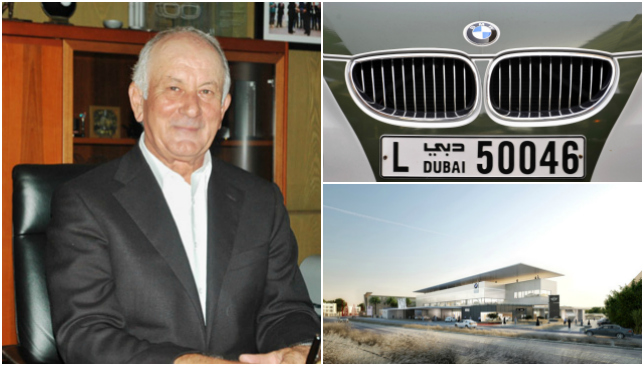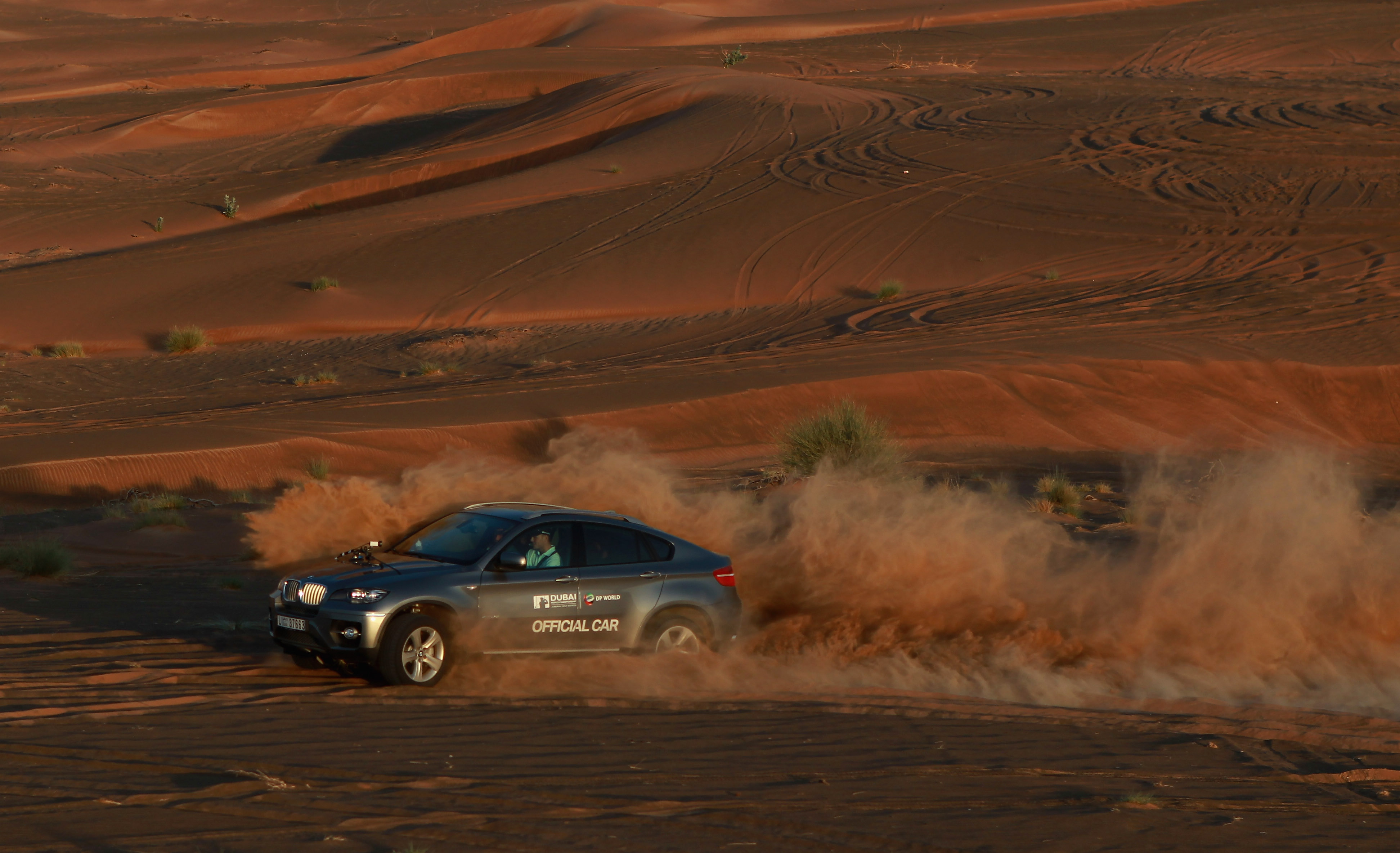
Stathis I. Stathis is a legend in his own right. He came to the UAE 40 years ago on a mission to introduce BMW to the region not knowing whether he was setting out a road to success or failure.
But his belief in the brand and the fact he was bringing a more sporty model into a market then dominated by Japanese and American cars, with Mercedes the dominant German manufacturer, drove him, AGMC and parent company Albatha Automotive to stunning success.
As they continue to celebrate their 40th anniversary Stathis took time to speak to Sport360 editor Steve McKenlay about how the business, which now includes Rolls-Royce and Mini, grew and why AGMC is about to invest Dh200m building a new state-of-the-art showroom in Motor City.
So, Stathis how did it all begin?
I started in the UK from 1967 to 1972 and then I went back to Cyprus where my job was service manager for BMW. So right from day one I have been involved with BMW. At that time it was a fairly small company that had been deve-loping aircraft engines and motor-cycles but they were beginning to develop small cars but it was a very small market compared to Mercedes, for example, who were already, at that time, well established. Audi didn’t even exist then.
In 1974 we had the Turkish invasion so I took a couple of years out and at the same time BMW offered the agency here in the UAE to the Cyprus importer. It was a partnership between the Cyprus importer and the Sheikhs who were the owners of Albatha which was always there but not marketed or advertised. Eventually the Cyprus importer left and Albatha took over the full ownership in 1990.
I arrived in the UAE in March, 1976, as service manager. There was just three of us so we started basically from zero. It took us two years to get 150 cars on the road and then we had to invest in aftersales with a workshop and so on. We opened the first showroom in Sharjah in an area which is still called the BMW roundabout. After about two years we had five mechanics and as the business grew we employed more people. The next investment was to open a showroom in Dubai with aftersales attached to it and that was done in 1987, near Dubai Airport. By that time it was clear BMW was becoming a serious player in the premium sporty market.

How competitive was the market in your first two years?
When we set up our aim was to test the market so nobody knew how BMW was going to develop because they were small cars. Yes, compared to the average car they were a bit more sporty, which has always been in the company’s DNA, but it was still impossible to tell how they were going to sell.
At that time did you believe BMW would become so big?
I was a BMW maniac from the start. Nobody could convince me otherwise because being in the business I could see, even from the early days, that they were going out of their way to come up with technology and a product which was superior. At that time they were developing at a much faster pace than anybody else. Their competitors were sitting there enjoying their success but they were overlooking the fact that this small-timer was coming up at a much faster pace.
It was difficult to start with because the market was full of American and Japanese cars and Mercedes were outselling us 20 to one. We believed in the product but we had to convince the customers so we gave a lot of attention to aftersales. We believed that mouth to mouth advertising was the best way to do it. So we made sure that everybody who was driving a BMW was happy beyond their expectations. So slowly, we started gaining ground hand in hand with BMW. It was interesting at that time because with the weather conditions here BMW had to rely on our reports on how the cars behaved so they could develop air conditioning and engine cooling.
Even in those days, in the early eighties, they were sending their prototypes here and that helped a lot. Although the market for BMW was pretty small here they were showing that they planned to expand in order to solve the hic-ups, and we had plenty of those.
What were the main problems in those early years?
The air conditioning was poor. The cars were overheating because they weren’t originally built for such weather conditions. But BMW’s determination to solve these problems and a willingness to invest time and a considerable amount of money meant at that time they were ahead of the competition.
At what stage did you see a significant increase in sales?
In 1990 BMW started developing bigger cars and by that time, with the 3 Series, we were dominating the small car market so we were confident that whatever was coming next would be competitive. So after the 3 Series, came the 5 Series and then eventually the six and 7 Series. By 1992 we reached 600 units which was a respectable number but still below our main competitor, Mercedes but now they were only outselling us by two-and-a-half to one. By 1995 we got it down to one-and-a-half to one and we were well established. We opened the Sheikh Zayed Road showroom in 1996 and business started to take off, particularly with the arrival of the X5 SUV.
Did you know then that there was huge potential for SUVs in the UAE?
When BMW were developing the X5 there was some uncertainty as to what direction they should go so we said, okay, here is a car with on-road performance and off-road capability which was totally new to the market. It took time for people to realise that this car did not compromise on quality and sportiness, had on and off-road capability and a nice high position where they could see everything. I think it was the first time I sat here saying to people that we had no more cars. It was a big success. It was the first of its kind and set a trend that all the others followed.
Did the X5 give you the most significant spike in sales?
The first year after launch we sold 1,000 vehicles which was one-and-a-half times our normal sales. That car gave us a breath of fresh air and it still remains as popular as ever.
BMW has a strong motorsport heritage with a lot of success on the track. Have you used this to help market your cars?
Sport has always been part of the BMW DNA and we brought Nelson Piquet over here for an event when he was driving for BMW in F1 but you have to match that with comfort and luxury and while racing probably helped sell the BMW dream in the UK and Germany, it wasn’t quite so important here.
We were more focused on marketing events. We were doing black tie events for 2,000 people and nobody else was doing anything like that. In the end people were begging us to invite them. I remember at the opening of the Burj Al Arab the next day we had the launch of the Z8, with a James Bond activity. We used to spend a lot of money on that sort of event where we create a relationship with our clients. We knew how important it was to get into the hearts of people in a nice way and they thought we were good people to do business with.
We have a lot of loyal customers and we still believe in that philosophy. It put us in a good position, particularly now with the competition very fierce in a difficult market with very similar products.
It's been a big week for the #BMWPGA - from the Practice Range to Piccadilly Circus & @NiallOfficial to @LukeDonaldhttps://t.co/zPOUspQtkh
— BMW PGA Championship (@BMWPGA) May 28, 2016
BMW are also a European Tour partner sponsoring the PGA golf championship at Wentworth and the DP World Tour Championship. Does sport sell cars?
Yes, sports sponsorship is one way to gain brand awareness. I don’t like the fact that BMW pulled out of Formula One but they did some studies and the majority of people didn’t care whether BMW was racing or not.
Because of the lifestyle and the environment here we have learned the best way to do business with customers here. BMW now come and ask us how to sell the 7 Series for example. We influenced the 7 Series development in a big way and the X7 is on its way which is coming because we asked for it.
It’s the same with Rolls-Royce. They sell 60 cars in Germany and we sell 200 and that’s not because there are no rich people in Germany. It’s all about the way you treat your customers.
Has the strategy you used for your business changed significantly over the years?
The basic strategy hasn’t changed but the way we operate has to meet market requirements. The main focus is always to have a satisfied customer. The size we have reached makes it difficult for us to give a personalised service. So we expand more and go where our customers want us to be and that is why we are building a new showroom in Motor City.
BMW dealership finds parking at Dubai Motor City https://t.co/pt6UVHlvnF pic.twitter.com/2uu0y1cTnk
— Dubai Informer (@Dubaiinformer) April 14, 2016
Why are you investing Dh200m in a new showroom in Motor City at a time when the market is so challenging?
We are doing what we have to do. Dubai has the same philosophy in that when things get tough we get going. We believe that this challenging market is temporary and that Dubai will always be a vibrant market. In Motor City we will be surrounded by expats who are our customers so we will take this opportunity with a different type of facility which is more environmentally friendly, offers a more family orientated facility.
We want to reflect BMW’s full philosophy. The fact that we have Dubai Autodrome there will also give us opportunities for customers to test drive cars or motorcycles. We are even talking about developing an advance driving school at the Autodrome.
Are you noticing a growing demand for hybrids and electric cars from customers?
This change is what worries everybody because companies like BMW, Mercedes and Audi who rely on driving pleasure have to deal with electric power which is actually working against brands like this, so it is a problem. Within the next 20 years they are going to have to come up with some dramatic innovations to keep their leadership in the market.
What is the biggest challenge facing you now?
The big problem is the world economy and political stability, the outside influences that none of us can do anything about but so far, so good. The biggest concern is how manufacturers will handle legislation where they are forced to reduce emissions so much that they have to cut down on the number of cylinders.
The technology is there but to apply it in a country like this is not going to be easy.